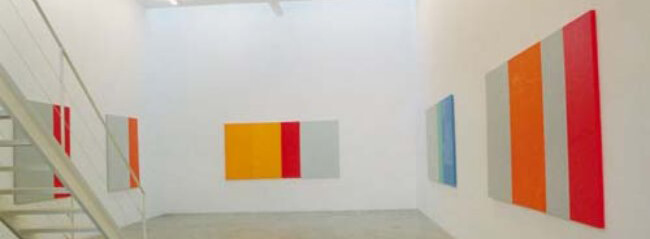2002
A Possible Place - Taisa Helena Pascale Palhares
Galeria Barô Senna
The ability to divide the canvas precisely into fields to later rearrange them according to a color palette, maintaining the same divisions until the end of the process and supressing the independence of each one of the parts has always been one of the major assets of Renata Tassinari´s work. In her paintings the contrast between colors and surfaces produced a kind of unequal rhythm among the different fields that left out a feeling of reducing sameness.
This process seems to have been radicalized in the artist´s recent paintings. What we see now is a comeback of the precise geometrical ordering of the canvas in strips and rectangles of the same size that double or triple the size according to the color of the areas, following a stage in which she tried to work with a deeper sense of a fluid passage between colors (1998 exhibition) that is visible in some of the drawings shown today.
Again that kind of iregular dynamism emerges, in spite of the regular division of the canvas, resulting from the relation between surfaces and colors of several qualities.
Just like Matisse, who would choose his colors according to a purely sensitive criteria and observing the relations between them at the very moment of painting, Renata seems not to follow any preestablished order when choosing her colors or any easily identifiable method by the viewer. When seen together the paitings show very similar hues, each one with an indomitable movement. Her light and malleable air geometry involves the viewer with its swaying movement.
Since her first works the canvas area has been permeated with contrasts between opacity and brightness, roughness and smoothness - diferences that caught the viewer´s eyes and determined the time to understand her works. However, only now with the use of those opaque and expansive gray areas (first seen in drawings and in some of the 2000 series), combined with the luminosity and thickness of the blue, orange, green, yellow and red zones, her rhythm is able to establish an effectively spatial dimension beyond the limits imposed by the canvas. In this new production, the movement coming from contrasts is not just something that only produces inner space, dynamic, albite closed in it, but allows its diffusion and comunication between the work and the envinroment.
Here the gray area works as a relaxing ground for the eye. It seems to expand and project the most colorful fields forward giving them greater material quality. Likewise, the projected colors reflect on the gray area, giving it different values and depths. This back and forth movement, which appears in the explicit divisions of the canvas, creates a semi-architectonic space with which the viewer seems to interact.
Today, one of the major challenges of painting is to be able to point out a place in the world and establish a revealing mediation between man and its time with its own elements (a task that is not exclusive of this form of art, but of all artistic construction) – all done deliberately. Renata Tassinari, with her geometry that allows itself to permeate in the world that knows how to respond to contingencies withou losing its course, conceives a place where the closeness between regularity and spontaneity appears as possible reality.
